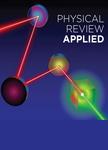版权所有:内蒙古大学图书馆 技术提供:维普资讯• 智图
内蒙古自治区呼和浩特市赛罕区大学西街235号 邮编: 010021

作者机构:Key Laboratory of Time Reference and Applications National Time Service Center Chinese Academy of Sciences Xi’an 710600 Shaanxi China School of Astronomy and Space Science University of Chinese Academy of Sciences 100049 Beijing China Hefei National Laboratory Hefei 230088 Anhui China State Key Laboratory on Integrated Optoelectronics Institute of Semiconductors Chinese Academy of Sciences 100083 Beijing China School of Electronic Electrical and Communication Engineering University of Chinese Academy of Sciences 100049 Beijing China Center of Materials Science and Optoelectronics Engineering University of Chinese Academy of Sciences 100190 Beijing China
出 版 物:《Physical Review Applied》 (Phys. Rev. Appl.)
年 卷 期:2025年第23卷第1期
页 面:014078-014078页
核心收录:
基 金:National Natural Science Foundation of China, NSFC, (61801458, 12074309, 12203058, 12103058, 61875205, 12033007) National Natural Science Foundation of China, NSFC Chinese Academy of Sciences, CAS, (XDC07020200, QYZDB-SSW-SLH007) Chinese Academy of Sciences, CAS Youth Innovation Promotion Association, YIPA, (2021408, 2022413) Youth Innovation Promotion Association, YIPA China Postdoctoral Science Foundation, (2022M723174) China Postdoctoral Science Foundation
摘 要:Microwave frequency mixing is a fundamental functionality in microwave photonics, playing a crucial role in modern radar and wireless communication systems. Classical microwave photonic mixers require both the radio frequency (rf) signal and the local oscillator to be loaded onto the same optical light source, thereby impeding their capability in the context of distributed microwave systems. Using time-energy–entangled biphotons as the optical carrier, the quantum microwave photonic (QMWP) mixer offers a promising solution for attaining nonlocal mixing and surmounting such limitations. In this paper, we explore two types of QMWP mixer based on the configuration of the intensity modulators: cascade type and parallel type. Both QMWP mixers feature the properties of high linearity and dual outputs, with their spurious-free dynamic ranges being identical to that of the equivalent classical microwave photonic mixer. Specifically, the parallel-type QMWP mixer can nonlocally mix two physically separated rf signals, demonstrating its superiority in distributed microwave and millimeter-wave radar systems. Further, by application of multiphoton frequency-entangled sources as optical carriers, the nonlocal microwave frequency conversion capability endowed by the QMWP mixer can be extended to enhance the performance of multiple-path microwave mixing, which is essential for radar net systems.